For the 2025 school year, there is 1 public high school serving 374 students in Clay County Schools School District. This district's average high testing ranking is 8/10, which is in the top 30% of public high schools in North Carolina.
Public High School in Clay County School School District have an average math proficiency score of 75% (versus the North Carolina public high school average of 58%), and reading proficiency score of 62% (versus the 58% statewide average).
Public High School in Clay County School School District have a Graduation Rate of 77%, which is less than the North Carolina average of 85%.
The school with highest graduation rate is Hayesville High School, with 75-79% graduation rate. Read more about public school graduation rate statistics in North Carolina or national school graduation rate statistics.
Minority enrollment is 14% of the student body (majority Hispanic), which is less than the North Carolina public high school average of 55% (majority Black and Hispanic).
Overview
This School District
This State (NC)
# Schools
4 Schools
761 Schools
# Students
1,301 Students
565,764 Students
# Teachers
91 Teachers
33,453 Teachers
Student : Teacher Ratio
14:1
14:1
District Rank
Clay County Schools School District, which is ranked within the top 30% of all 320 school districts in North Carolina (based off of combined math and reading proficiency testing data) for the 2021-2022 school year.
The school district's graduation rate of 75-79% has decreased from 85-89% over five school years.
Overall District Rank
#97 out of 325 school districts
(Top 30%)
(Top 30%)
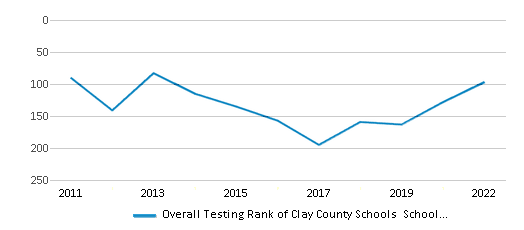
Math Test Scores (% Proficient)
60%
51%

Reading/Language Arts Test Scores (% Proficient)
55%
50%
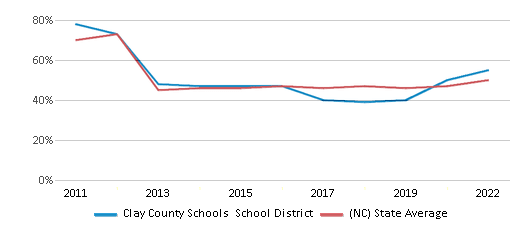
Science Test Scores (% Proficient)
68%
63%
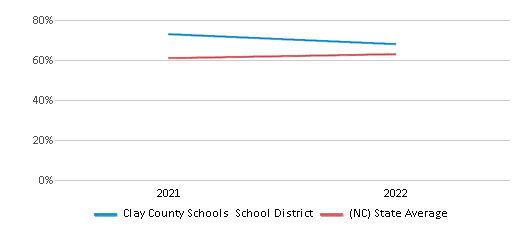
Graduation Rate
75-79%
86%
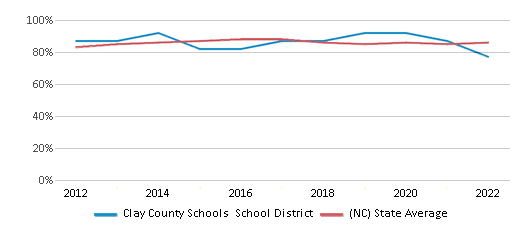
Students by Ethnicity:
Diversity Score
0.26
0.70
# American Indian Students
7 Students
5,772 Students
% American Indian Students
1%
1%
# Asian Students
3 Students
21,293 Students
% Asian Students
n/a
4%
# Hispanic Students
119 Students
115,235 Students
% Hispanic Students
9%
20%
# Black Students
7 Students
138,700 Students
% Black Students
1%
24%
# White Students
1,111 Students
254,801 Students
% White Students
85%
45%
# Hawaiian Students
1 Student
765 Students
% Hawaiian Students
n/a
n/a
# Two or more races Students
53 Students
30,969 Students
% of Two or more races Students
4%
6%
Students by Grade:
# Students in PK Grade:
72
491
# Students in K Grade:
98
6,922
# Students in 1st Grade:
105
6,949
# Students in 2nd Grade:
112
7,207
# Students in 3rd Grade:
78
7,125
# Students in 4th Grade:
79
7,196
# Students in 5th Grade:
100
7,763
# Students in 6th Grade:
100
11,146
# Students in 7th Grade:
93
12,024
# Students in 8th Grade:
90
12,284
# Students in 9th Grade:
97
137,976
# Students in 10th Grade:
114
126,349
# Students in 11th Grade:
78
117,582
# Students in 12th Grade:
85
104,750
# Ungraded Students:
-
-
District Revenue and Spending
The revenue/student of $12,883 is higher than the state median of $11,187. The school district revenue/student has stayed relatively flat over four school years.
The school district's spending/student of $12,477 is higher than the state median of $11,612. The school district spending/student has stayed relatively flat over four school years.
Total Revenue
$17 MM
$17,307 MM

Spending
$16 MM
$17,964 MM
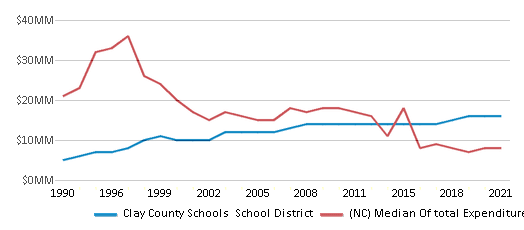
Revenue / Student
$12,883
$11,187
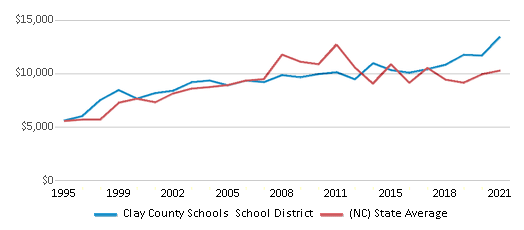
Spending / Student
$12,477
$11,612
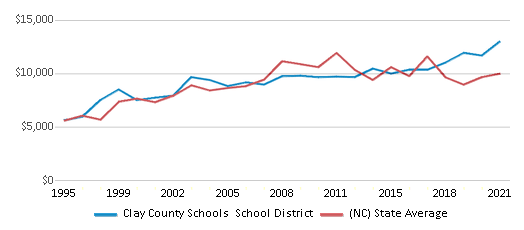
Best Clay County Schools School District Public High Schools (2025)
School
(Math and Reading Proficiency)
(Math and Reading Proficiency)
Location
Grades
Students
Rank: #11.
Hayesville High School
(Math: 70-79% | Reading: 60-64%)
Rank:
Rank:
9/
Top 20%10
205 Yellow Jacket Drive
Hayesville, NC 28904
(828) 389-6532
Hayesville, NC 28904
(828) 389-6532
Grades: 9-12
| 374 students
Recent Articles

What Is A Charter School?
Explore the world of charter schools in this comprehensive guide. Learn about their history, how they operate, and the pros and cons of this educational innovation. Discover key facts about charter schools, including admission policies, demographics, and funding, as well as what to look for when considering a charter school for your child.

10 Reasons Why High School Sports Benefit Students
Discover the 10 compelling reasons why high school sports are beneficial for students. This comprehensive article explores how athletics enhance academic performance, foster personal growth, and develop crucial life skills. From improved fitness and time management to leadership development and community representation, learn why participating in high school sports can be a game-changer for students' overall success and well-being.

February 05, 2025
Understanding the U.S. Department of Education: Structure, Impact, and EvolutionWe explore how the Department of Education shapes American education, from its cabinet-level leadership to its impact on millions of students, written for general audiences seeking clarity on this vital institution.





